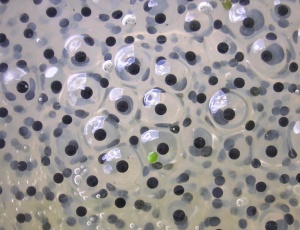2009 Group Project 5
The Embryology of Frogs
Growth and development of the Frog

The frog is well recognised species, abundant predominantly in ponds, swamps, though various of frog species may also exist in damp or shady environments distant from the water. Eggs of specific frogs are easily obtained and may be examined in from the beginning of fertilization onwards. The phases of embryonic development differs in various chordates, yet the typical phases are basically apparent in all frog species. The differences are associated principally to the amount of yolk particles present in an egg. The yolk particles offer nourishment of the developing embryo. The process of frog development will be discussed from the phases of gametogenesis to the adult stage. --Joe Nassif 17:29, 19 August 2009 (EST)
The Egg
The embryology of a frog egg is a vast cell; its dimensions are approximately 1.4-1.6 million times larger than a typical aquatic species egg cell. Throughout the frog’s embryonic maturation period, the egg will be transformed into a tadpole encompassing millions of cells but still remains with its constant volume of genetic material. The early embryonic frog structure consists of three main segments the superior hemisphere known as the animal pole which is usually visible as the darkest area. The innermost layer appears to be between the outer two sections known as the gray crescent. Inferiorly, represents the vegetal pole typically lighter than the superior compartment.--Joe Nassif 17:29, 19 August 2009 (EST)

Project Content:
1.The Egg
2.Fertilization
3.Cleavage JOE NASSIF z3295026 (first 6 topics)
4.Gastrulation
5.Differentiation
6.Growth
Gastrulation
The start of gastrulation is marked by the pushing inward of the cells in the region of embryo. This produces, first, an opening that will be the future anus. Second, a cluster of cells that develops into the Spemann organiser. As gastrulation continus, three different germ layers are formed. These are ectoderm, mesoderm and endoderm. --Gang Liu 18:27, 19 August 2009 (EST)
7.Timeline -how long
8. Diagram (Hand-drawn)
9. Germ-layer origin of various body tissues
10.Developmental factors associated with specfic stages of growth
11. Staging - are there species specific staging, what occurs when
12.History of Model Use - when was it first used, what embryology research
13.Genetics - chromosome number, sequencing
14. Current Embryology Research - research papers and findings
== Links - Frog Embryology: ==
1. [1]
2. [2]
3. [3]
4. [4] Just a little cycle of FROG'S life cycle
5. [5]
the biology of a frog scribd
ANAT2341 group projects
Project 1 - Rabbit | Project 2 - Fly | Project 3 - Zebrafish | Group Project 4 - Mouse | Project 5 - Frog | Students Page | Animal Development